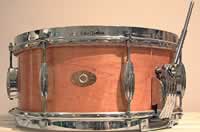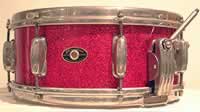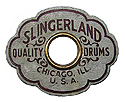| 
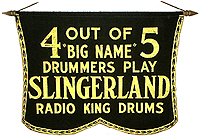
| 1951 Catalog |
|
|
1955 Catalog |
|
|
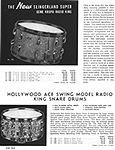 |
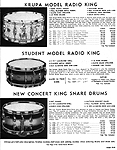 |
In 1951 one is the first year for.... |
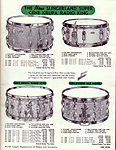 |
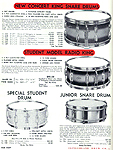 |
1955 the Super gene Krupa was introduced.... |
| The name "Radio King" was used on snare
drums and drum sets from at least 1936 until 1957. The name temporarily
disappeared from catalogs for a few years and came back approximately
in 1960. From that point on it was still used for snare drums. Here
is an example of a rim stamp for a Slingerland Radio King Snare. |
|
Here I would like the years and
the models of snare drums.
Construction of all wrapped "Radio King" toms and bass drums
was 3 ply, in a 1/16" mahogany/1/8"poplar/1/16" mahogany
layup. Duco and clear finished toms and bass drums had outer plies of
maple. They had solid maple reinforcing rings which started out almost
2" wide in the 30s and 40s, diminished to about 1 1/2" in
the early 50s and wound up at about 3/4" after 1955 when the line
was retooled and "Sound King" hardware was introduced.
Here I will take pictures of
the shell plies for the three drums I have.
Real "Radio King" snares had solid one-ply steam-bent maple
shells ("Student Radio King" was the designation Sling used
for entry level wood snares in the 40s and 50s; they had the above 3
ply layup shells), with solid maple reinforcing rings.
From the 1930s through the early postwar period (1947 was the changeover
I believe), Radio King toms and basses came standard with "Streamline"
(or "cigar") lugs and had "Radio King" engraved
clip style "stickchopper" rims. Snares had either double ended
Streamline lugs (for 5"-6.5" drums) or a double row of small
"Beavertail" lugs (7" and up), engraved double flange
rims and "3 point" or "Super" ("clamshell")
strainers. Small Beavertails could be special ordered on toms and basses
as well. Basses and snares in this period had some variation of the
"Cloud" badge. No toms in sets designated "Radio King"
in any period had badges of any kind.
Starting at the postwar changeover (about 1947) toms and basses came
standard with newly designed large Beavertail lugs and engraved double
flange rims. Snares continued as before, but clamshell strainers became
increasingly common. Snares and basses in this period had "large
oval" (1947-1950), "small oval" (1951-1953) brass scroll
badges, or stamped "dogtag" brass badges (1954).
In 1955, Slingerland revamped their lines and introduced
the "Sound King" hardware. From then until 1957 when the "Radio
King" name disappeared, toms had small SK lugs, basses had large
SK lugs and snares had double ended SK lugs. Snares and toms had reverse-curve
triple flange "Rimshot" (or "sticksaver") rims.
Basses and snares had the dogtag ('55-early '56) or black/brass "Chicago"
badge.
Here I would like to have pictures of the different type
lugs and some feature hardware like tone controls strainers and butt
sides
Standard finishes were limited in all these years to
blue/silver and gold/black Duco, White Marine and Black Diamond pearl,
and red, blue, green, silver and gold sparkle. There were probably a
few more colors offered in '56 and '57, the last of the "Radio
King" kits, but I don't have catalogs from those years to say for
sure. I'm not certain if Sling actually offered clear-finished Radio
King kits, but no doubt a few exist. In the early years, Sling offered
a few "full dress" finish options (contrasting sparkle diamonds,
etc) but these became less common later on.
Here I would like to show the different types of finishes
1957-1962, top end Slingerland kits continued to be virtually identical
to the above description with minor changes year to year (like many
more color choices), but were no longer called "Radio Kings".
This being Slingerland, exceptions to virtually every general rule
above exist, but this describes probably 95% of all "Radio Kings".
Those are the high spots. I may have gotten some details wrong. Anybody
else please feel free to correct them.
P.S. I forgot to mention the wartime (1942-1945) "Rolling Bomber"
kits which substituted wood for most of the metal parts (lugs, hoops,
snare strainers, tom legs, etc). I don't know much about these so I'll
let somebody else describe them if they want to. |








